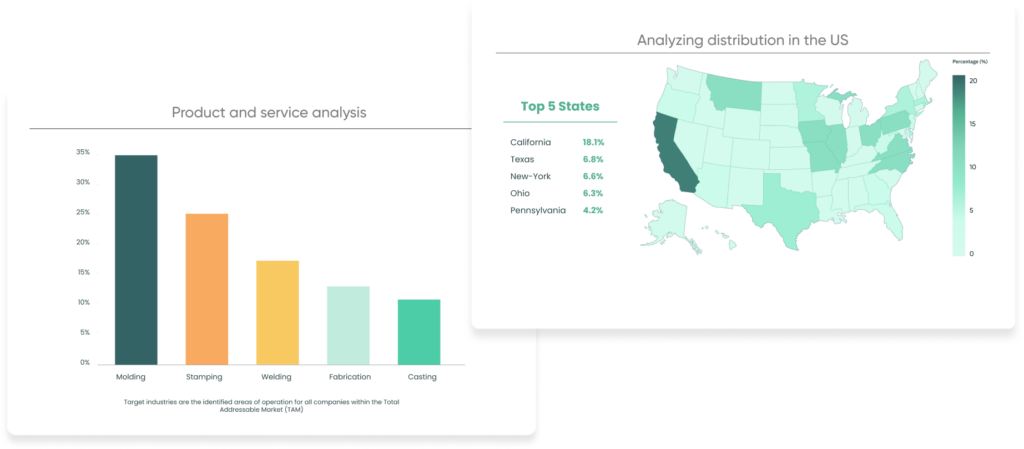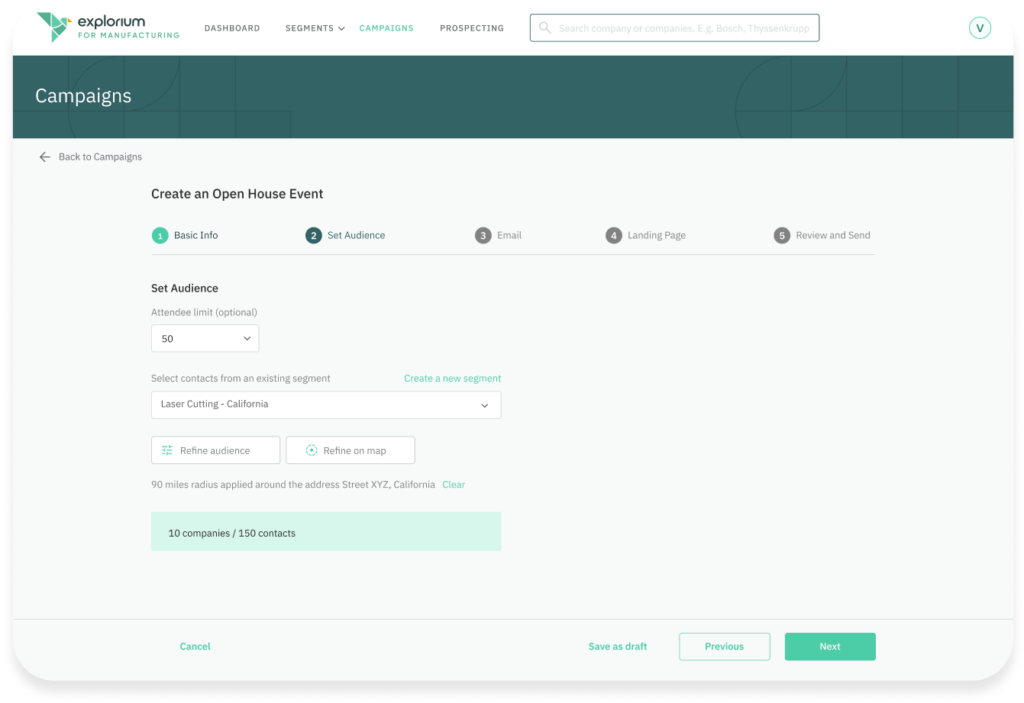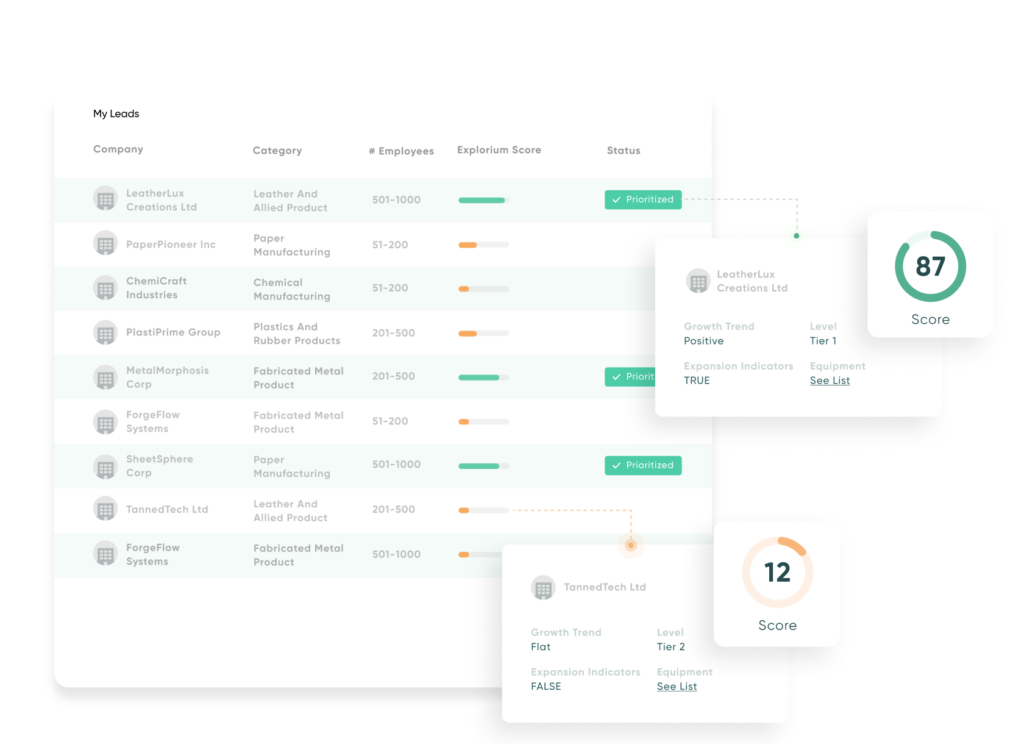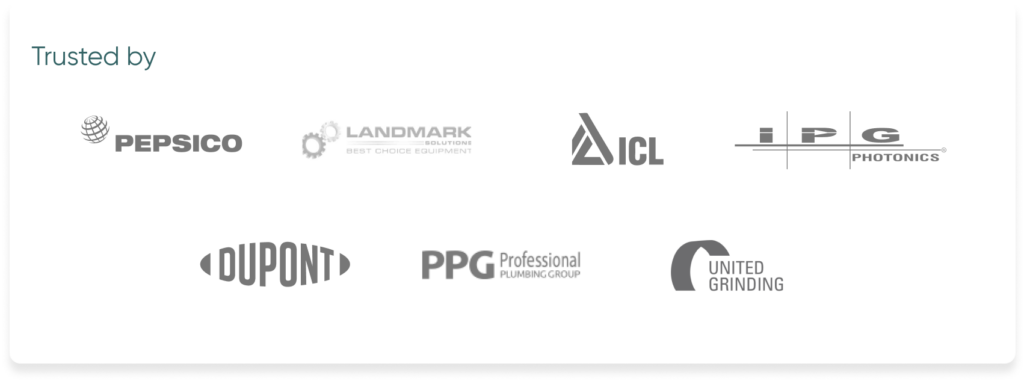Table of Contents
Introduction
Trade shows are not just another marketing tool, they are a unique platform that offers industrial product manufacturers the opportunity to showcase their products, network with key decision-makers, and generate valuable leads. These events provide a golden opportunity to bring the right prospects directly to your booth and turn connections into lasting partnerships. But to truly capitalize on trade show participation, you need more than just an eye-catching booth—you need a strategic, data-driven approach that can unlock the full potential of these unique opportunities.
This article explores strategies for leveraging trade shows to maximize impact, focusing on pre-show preparation, effective in-event engagement, and post-show follow-up. We’ll also highlight how Explorium.ai’s enriched data capabilities can give you an edge every step of the way.
Importance of Trade Shows in Industrial Marketing
Trade shows are a vital part of industrial marketing, offering manufacturers a chance to achieve multiple goals in a short time: generate leads, enhance brand awareness, showcase new products, and even secure media exposure in an industry where relationships and trust matter, nothing beats the power of face-to-face interactions and live product demonstrations. This direct engagement with key decision-makers can help your products stand out and create a lasting impact.
Consider the various types of industrial
trade shows:
Vertical Trade Shows focus on a single industry, like FABTECH, which showcases metal forming and welding innovations. The International Manufacturing Technology Show (IMTS), with over 130,000 attendees, is an annual event that is a golden opportunity for industrial businesses to network with relevant buyers and familiarize themselves with cutting-edge technologies. These shows attract professionals directly involved in the sector, giving you a highly targeted audience to connect with.
Horizontal Trade Shows cover multiple industries, such as Hannover Messe, which draws over 200,000 global visitors from the energy, logistics, and manufacturing sectors. These events are great places to make lasting cross-industry connections.
Regional/Niche Trade Shows, like the Midwest Manufacturing Expo, offer a more localized approach. At these shows, you can build close, personalized relationships with local suppliers and customers.
Finally, Exhibitor-Specific Trade Shows, such as GE’s Innovation Expo, allow companies to create exclusive events to showcase their product lines to key market players.
No matter the type of trade show, strategic preparation and data-driven engagement are critical to maximizing the opportunity.
Pre-Show Preparation: Setting Goals and Planning
A successful trade show begins long before the event starts. Preparation is critical, and it involves setting clear goals, selecting the right shows, and building an engaging booth.
Defining Clear Marketing Objectives
Start by defining your goals for the trade show. Are you looking to generate new leads, boost brand awareness, launch a product, or explore partnership opportunities? A clear, measurable objective keeps your team focused on the most critical outcomes. For example, if your goal is to generate high-quality leads, every activity—from booth setup to promotional materials—should be geared toward capturing those contacts. This clear focus will ensure that you are fully prepared and ready to make the most of the trade show.
Selecting the Right Trade Shows
Choosing the right trade show is equally important. If you’re targeting international markets, a global event like the Industrial Automation Fair in Shanghai may be ideal, bringing together over 120,000 attendees worldwide. On the other hand, if your goal is to engage more closely with a niche audience, a regional event like the Offshore Technology Conference (OTC) might provide more intimate engagement opportunities.
Aligning your trade show selection with your target audience and marketing goals ensures you get the most value out of your participation. For startups or smaller manufacturers, a niche, regional show could allow for more focused conversations, while larger firms may benefit from the extensive networking opportunities of major international shows.
Building a Strategic Booth Setup
Once you’ve selected the right trade show, it’s time to design your booth. The goal is to create an engaging and interactive space that effectively showcases your products. Consider using interactive displays, virtual reality demos, and live product demonstrations to attract visitors and highlight the practical value of your offerings.
Strategically placing your booth in a high-traffic area can also maximize visibility. A well-designed layout invites attendees in, starts the conversation, and ensures that your visitors leave with a positive impression of your brand.
With AI-powered solutions, businesses can create precise customer segments based on their needs and preferences. These segments help manufacturers target the right companies and craft messages that resonate. Precise segmentation means fewer wasted calls, more productive conversations, and a greater return on effort.
Using Data to Target the Right Attendees
One of the key aspects of data-driven targeting is understanding your Total Addressable Market (TAM). This is where Explorium can help. It specializes in helping companies uncover their TAM—a critical component of data-driven targeting. By taking the Ideal Customer Profile (ICP) you provide, Explorium builds a comprehensive view of your TAM, including new segments and opportunities you may not have previously considered
For example, if you’re preparing for a significant trade show, Explorium’s enriched data can help you determine:
- Number of Companies in the TAM: Explorium provides a detailed analysis, comparing what’s in your CRM versus newly discovered potential clients, ensuring every opportunity is noticed.
- Engagement Levels: By examining data signals, you can determine which companies are most ready to engage, helping you prioritize your time and focus.
- Territory Distributions: Explorium’s insights into geographic data—such as city- or state-level concentrations of ideal prospects—can help you optimize booth location, allocate sales reps effectively, and plan your sales route after the event.
- Essential Data Points: Explorium also identifies hard-to-find information like facility locations, equipment financing (UCC filings), and government contract wins, giving you a competitive edge when preparing for outreach.

Pre-Event Outreach and Engagement
Engaging with prospects before the event ensures you’re already on their radar when they arrive. Use email campaigns, targeted social media ads, and personalized invitations to pique their interest. Send customized product information to attendees who fit your ideal profile and invite them for one-on-one demos at your booth.
For example, if a prospect has shown interest in automation solutions, sending a personalized invite for a demo can significantly increase the likelihood that they’ll visit your booth. Explorium’s data can make this targeting precise and effective, increasing conversion rates before the trade show doors open.

Effective In-Event Engagement Strategies
When the trade show begins, it’s your time to shine. But just showing up isn’t enough—you need to keep attendees engaged, informed, and interested.
( 1 ) Live Product Demonstrations
Live demos are the main attraction at any trade show. Industrial buyers want to see your product in action—how it works, what it does, and how it can solve their specific challenges. Tailor these demonstrations to different audience segments, whether Tier 1 suppliers, aftermarket buyers, or OEMs, ensuring each visitor understands their unique needs.
( 2 ) Engaging Presentations and Workshops
Consider hosting mini-workshops or technical presentations to provide value beyond the booth. You could offer insights on industry trends, practical applications of your products, or case studies showcasing successful implementations. This would position your company as a thought leader in the industry and build a sense of community among attendees.
( 3 ) Real-Time Lead Scoring and Qualification
Only amateurs wait until after the event to start scoring leads. With real-time data tools, you can analyze attendee engagement at your booth as it happens. By scoring leads based on their interactions and level of interest, your sales team can focus on the hottest prospects immediately. Explorium’s enriched data helps you qualify prospects on the spot, setting the stage for efficient follow-ups.

Post-Show Strategies for Maximizing ROI
The trade show may be over, but your work still needs to be finished. Post-show strategies are critical for converting leads and measuring the success of your efforts.
( 1 ) Timely and Targeted Follow-Ups
Follow-ups are where you turn interest into action. Use the gathered data to personalize your outreach—send tailored emails, product catalogs, detailed proposals, or case studies aligning with each prospect’s interests. Timing is crucial—strike while the interest is still fresh.
With Explorium, you can track and monitor your sales reps’ engagement with high-quality leads. Explorium’s segment activation tool allows you to compartmentalize outreach based on detailed criteria—like UCC filings, contract opportunities, and equipment data—so your team can focus on prospects with the highest buying intent.
( 2 ) Measuring Trade Show Success
Finally, measuring the success of your trade show participation is essential. Define key metrics such as the number of qualified leads, customer engagement, partnerships formed, and sales pipeline growth. Use CRM tools to track and assess the effectiveness of your trade show activities. Explorium’s data can provide insights into which strategies worked best, helping refine your approach for future events.
Real-World Examples of Successful Industrial Trade Show Marketing
( 1 ) Manufacturing Sector
At a recent trade show, a leading manufacturer transformed its success by using live demos combined with Explorium’s Predictive Prospecting solution. The company identified growth opportunities by tapping into data-driven market analysis and efficiently scored leads post-demo, driving significant interest and closing deals faster than ever.
( 2 ) Heavy Equipment Industry
Another industrial giant leveraged pre-event targeting using Explorium’s data capabilities to identify high-quality leads ahead of the show. Personalized follow-up campaigns helped them secure long-term partnerships with key players, showcasing the value of enriched data for building sustainable customer relationships.
Challenges of Industrial Trade Show Marketing and How to Overcome Them
Trade show marketing isn’t without its challenges—standing out from competitors, managing costs, and effectively tracking leads are common hurdles. A data-driven approach is critical to overcoming these obstacles. Explorium’s enriched data helps you target the right audience, optimize your marketing spend, and ensure that every lead is tracked and nurtured correctly.
Conclusion
Trade shows provide an unparalleled opportunity for industrial product marketing. By combining high-tech strategies with meaningful human interaction, manufacturers can generate leads and build brand awareness.
Ready to see how data can supercharge your sales prospecting?
Explorium offers enriched data — driven solutions that enable you to target your ideal customers and drive more sales faster. Explore our case studies to see how we’ve helped companies boost their sales performance — or better yet, connect with us for a personalized demo to learn how you can leverage data for a competitive edge today!


